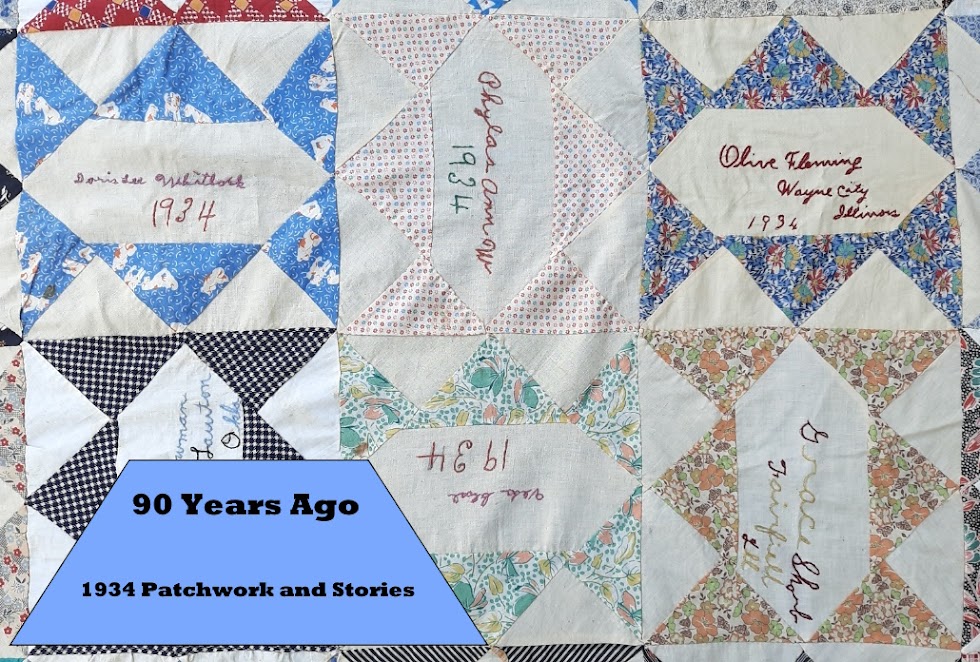Maude
Laughlin was a farmer’s wife – although it took her a long time to find her
farmer.
Maude
was 54 when she made her block for the quilt.
In 1937 Maude and farmer husband George had only been married a few
years. Both George and Maude had been
married before; Maude’s first husband was killed by a freight train as he was
walking along the railroad tracks.
George was a widower; neither George not Maude had any children.
In
the 1940 census George Laughlin’s occupation was listed as ‘farmer’ and the
number of hours worked in the previous week was 60. Maude Laughlin’s occupation was ‘housework’;
hours worked was left blank on the form.
I wonder if Maude was amused or dismayed by the lack of significance of
her labour compared to that of her spouse.
In
the late 1930s 25% of American farms were connected to the electricity
grid. Power poles ran alongside main
transport routes so connection depended on proximity to main roads. If the Laughlin’s farm did not have a grid
connection they would have other sources of power. Windmills, gasoline engines and sets of batteries
were standard power sources. Kerosene
lamps were used for lighting and the cellar or icebox would keep food cold.
Connecting
the farm to the electricity network was actively promoted in the 1930s
especially for dairy farmers. The modern
farmer needed pumps for automatic watering systems for cows to drink from;
milking machines; motorised cream separators; and of course refrigeration
instead of ice. Electricity saved labor
and farm costs and thus boosted profits.
When
the electricity arrived in the farmhouse the first use was for lighting. Next were electric irons and vacuum cleaners.
Kitchen refrigerators remained very
expensive for years and the uptake was slow.
In
1937 the thrifty housewife could trade in her old vacuum cleaner and purchase a
new one for $21, ten days free trial. An
electric washing machine with wringer was $29.95, although the modern gasoline
motor washing machine was still a best seller.
She could even buy an electric kitchen range from the mail order
catalogue with
…inside oven light, a sensational new feature. Lights up automatically as the oven door is opened, illuminating every corner of the oven.”
Contrary
to advertising electricity did not lessen the housewife’s workload. Social expectations changed with the new
power source. Meals had to be better
with more variety, houses needed to be cleaner and wardrobes of clothes were
more varied and laundered more often.
Housewives in 1940 worked about 60 hours per week on the housework –
just the same as their farming husbands.
“Orange Juice – This mixer is appearing in a new finish of chrome and white to fit the color scheme of the bride’s new kitchen. It beats, and mixes, and mashes, too. It has more strength than a dozen brides.”






Social Expectations..... wonder how those have changed the last 10 years with internet and Facebook, etc.?
ReplyDeleteFacebook is 12 years old and before that we had Yahoo Groups and emails. What was life like before we had social media?
DeleteI used to read books...
Our farm here got electricity in 1946 after my husbands grandmother died. Not sure if that was because she would have disapproved, or because her husband and son had to do all the cooking and housework as well as all the farm work. Two years later her son married a farm girl who did not know how to cook, surprisingly. She learned fast.
ReplyDeleteHere in Victoria, Australia, the last town to be connected to the electricity grid was Walhalla, an old gold mining town in the hills that now attracts the tourists. It finally got mains electricity in 1998.
Delete